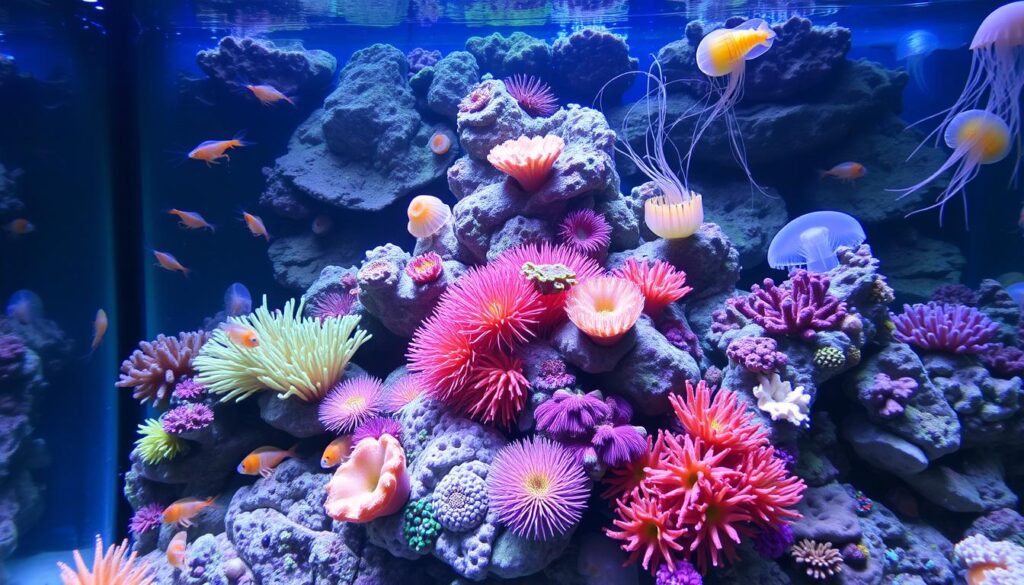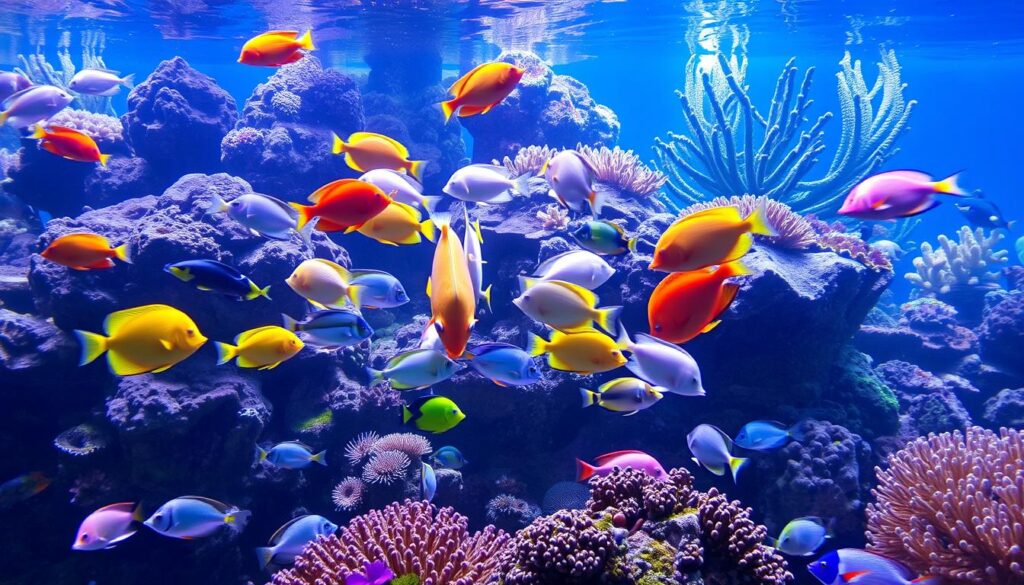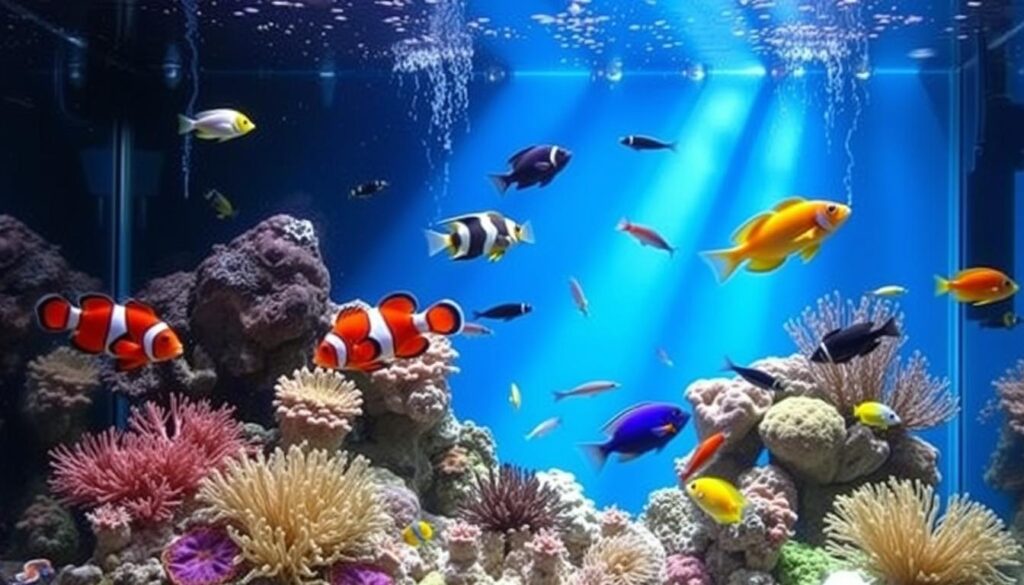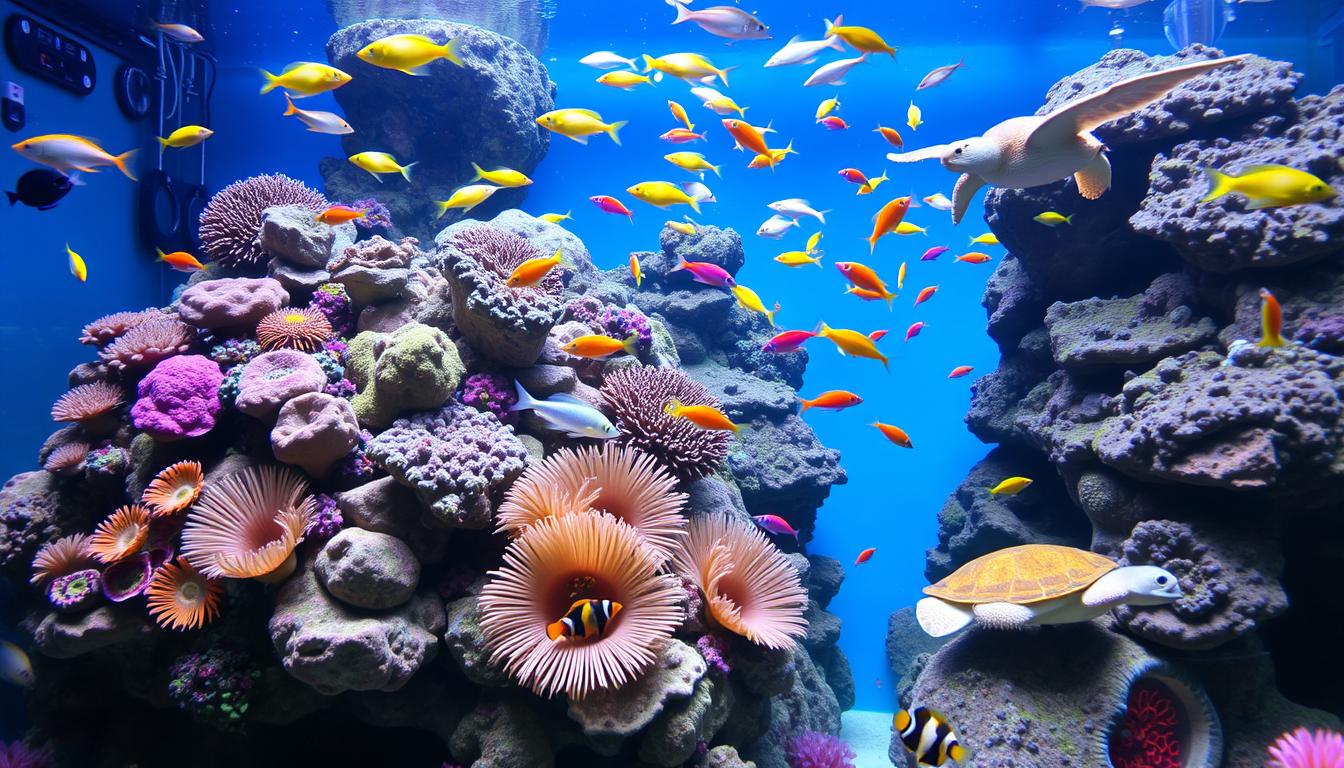Creating a thriving marine ecosystem in your saltwater aquarium needs careful planning. You must choose the right mix of fish, corals, and invertebrates. This ensures a balanced and healthy environment. By exploring different marine aquarium ideas, you can create a unique and fascinating space that showcases marine life’s beauty.
It’s important to understand the basics of saltwater aquarium stocking for success. This guide will give you the knowledge to make smart choices for your aquarium. We’ll cover everything from setting it up to ongoing care, ensuring your aquarium thrives.
Whether you’re new to aquariums or have experience, this guide will help you through the stocking process. It offers valuable insights and practical tips for keeping your marine life healthy. By following this guide, you can create a stunning and thriving saltwater aquarium that showcases marine life’s beauty.
Key Takeaways
- Saltwater aquarium stocking requires careful planning and attention to detail.
- Understanding the principles of marine aquarium stocking ideas is crucial for success.
- Selecting the right combination of fish, corals, and invertebrates is essential for a balanced ecosystem.
- Regular maintenance is necessary to ensure the health and well-being of your marine life.
- A well-planned saltwater aquarium can create a unique and fascinating environment.
- Research and understanding of saltwater aquarium stocking principles can help you avoid common mistakes.
Understanding the Basics of Saltwater Aquarium Stocking
Setting up a saltwater aquarium requires knowing the basics of water parameters and tank cycling. This ensures a healthy home for your saltwater tank inhabitants. You need to keep pH, ammonia, nitrite, and nitrate levels right. For more on setting up and stocking your tank, check out this guide. It talks about the need for good planning and water prep.
Cycling your tank before adding fish is key. It helps your tank become a balanced ecosystem. This reduces disease and stress risks for your marine life. Proper cycling makes your tank a great place for your fish to thrive.
- Water temperature and quality
- Tank size and capacity
- Compatibility of different species
By carefully thinking about these points and following the right setup and cycling steps, you can make a healthy and balanced home for your fish.
Planning Your Marine Ecosystem
Planning is crucial for a thriving saltwater aquarium stocking. You need to think about the fish, corals, and invertebrates that will live together. It’s important to know which ones get along to keep your tank healthy.
To plan your marine ecosystem, consider these factors:
- Tank size and capacity
- Water parameters and quality
- Species compatibility and temperament
- Space and swimming requirements
Understanding saltwater aquarium stocking is key to a balanced tank. By choosing compatible species, you can avoid problems and keep your aquarium thriving.
A well-planned marine ecosystem is vital for your fish’s health. By researching and understanding saltwater fish compatibility, you can create a stunning aquarium. It will bring you joy and fascination for years.
Essential Equipment for a Thriving Tank
When stocking your marine aquarium, the right gear is key. A top-notch filtration system is crucial. It keeps your water clean by removing waste and excess food.
A quality filtration system has three parts: mechanical, biological, and chemical. Mechanical filters get rid of solid waste. Biological filters break down organic matter. Chemical filters remove impurities and excess nutrients. This combo ensures a healthy ecosystem in your saltwater aquarium.
Filtration Systems
- Protein skimmers to remove waste and excess food
- Activated carbon to remove impurities and excess nutrients
- Bio-reactors to promote beneficial bacterial growth
Good lighting is also vital for your tank. It helps mimic the natural day-night cycle. This promotes healthy growth and behavior in your marine life.
Selecting Your First Fish Species
Choosing the right fish for your saltwater aquarium is important. Researching the needs of your desired fish is key for their health. Beginners often start with clownfish, damselfish, and butterflyfish. These fish are easy to care for and do well in a good saltwater tank.
Understanding which fish get along is crucial. Some fish need a lot of space, while others prefer to be in groups. Picking the right fish helps create a balanced and thriving marine world.
- Choose fish that fit your tank’s water and size
- Learn about the feeding needs of your fish
- Make sure your tank can grow with your fish
By following these tips, you can make a stunning and lively marine space. It will bring joy and wonder for hours.
Coral Selection and Placement Strategies
Corals are key in a marine aquarium, making it thrive. Choosing the right corals and placing them well is crucial. They add beauty and create a home for fish.
Soft corals are great for beginners. They’re easy to care for and can do well in a clean tank. Popular ones include leather corals, mushroom corals, and star polyps. Pick them based on their growth, color, and texture to match your tank’s look.
Soft Corals for Beginners
- Leather corals: known for their unique texture and vibrant colors
- Mushroom corals: easy to care for and can grow in a variety of shapes and sizes
- Star polyps: a popular choice for their striking appearance and relatively low maintenance requirements
Hard corals need more care and specific conditions to thrive. But, they can make your tank look amazing. Make sure to pick hard corals that fit your tank’s needs and the other marine life.
Adding Invertebrates to Your Aquarium
Creating a thriving saltwater aquarium means focusing on saltwater fish compatibility. Adding shrimp, crabs, and sea stars can make your tank more interesting. Before adding them, research their needs and how they get along with your fish.
A well-thought-out aquarium considers how all its creatures get along. Invertebrates can be a wonderful addition, but they need careful thought. Some are very sensitive to water, while others might fight with fish. Knowing what your invertebrates need helps create a peaceful and lively marine world.
Here are some key things to think about when adding invertebrates to your aquarium:
- Learn what your invertebrates need, like water conditions and food
- Pick invertebrates that go well with your fish and other tank friends
- Slowly introduce invertebrates and watch them closely to make sure they settle in well

By following these tips and thinking about saltwater fish compatibility, you can make a diverse and lively aquarium. Always put the needs and happiness of your fish and invertebrates first. If you’re not sure about something, ask someone who knows a lot about aquariums for help.
Creating Proper Marine Fish Communities
Creating a harmonious community of marine fish is key in saltwater aquarium stocking. A well-planned stocking idea is crucial for a balanced ecosystem. It’s important to consider the social behavior and compatibility of different fish species.
Understanding fish territories is vital for a thriving community. Some fish are territorial and need lots of space. Researching the specific needs of each species ensures peace among them.
Size and Swimming Level Considerations
Size and swimming level are also important in stocking ideas. Larger fish need more space to swim. Smaller fish are happy in smaller areas. Swimming levels matter too, as some fish like the surface, while others prefer the bottom.
Aggressive vs. Peaceful Species
When picking species, consider their aggression level. Peaceful species can live with calm fish. Aggressive species need careful thought to avoid fights. Choosing compatible species creates a thriving community.
Follow these guidelines to create a stunning marine fish community. Research and plan carefully for a successful saltwater aquarium stocking experience.
Maintaining Optimal Water Chemistry
Keeping the water chemistry right is key for your marine life’s health, especially with Saltwater fish compatibility. You need to test the water often for pH, ammonia, nitrite, and nitrate levels. This helps you keep the water stable and healthy for your best fish for saltwater aquarium.
To get the water chemistry just right, do regular water changes and watch the levels. Here are some important things to remember:
- Check pH levels to keep them in the best range for your marine life.
- Test for ammonia, nitrite, and nitrate often to avoid harm.
- Make sure the water moves well to stop it from getting still.
By following these tips and thinking about Saltwater fish compatibility, you can make a great home for your marine life. Always put your fish and other sea creatures’ health first.
Optimal water chemistry is the foundation of a healthy and thriving saltwater aquarium. By monitoring and maintaining the right parameters, you can ensure the well-being of your marine life and enjoy a beautiful and diverse aquarium.
Feeding Schedules and Nutrition Requirements
Feeding your marine life is key in a marine aquarium stocking ideas setup. A good feeding schedule and the right nutrition are vital. You need to offer a variety of foods to meet your marine life’s nutritional needs.
In saltwater aquarium stocking, knowing your food options is important. You have frozen, live, and dry foods. Each has its own benefits and drawbacks. For instance, frozen foods are nutrient-rich, while live foods keep your marine life mentally active.
Types of Marine Food
- Frozen foods, such as brine shrimp and mysis shrimp
- Live foods, such as copepods and amphipods
- Dry foods, such as pellets and flakes
Creating a feeding schedule is also crucial. Overfeeding can harm water quality, while underfeeding can lead to malnutrition. Feed your marine life 2-3 times a day, just enough for them to eat in a few minutes.

Specialized Feeding Techniques
Specialized feeding techniques can also help your marine life grow. Target feeding is great for specific species, while broadcast feeding works for many species at once.
Quarantine Procedures and Disease Prevention
Keeping a saltwater aquarium healthy is key. Quarantine and disease prevention are vital. This is crucial when adding new fish to your tank. It stops disease spread and ensures saltwater fish compatibility.
A quarantine tank is a separate space for new fish. It lets you watch their health before adding them to your main tank. This way, you can prevent diseases from spreading.
To create a quarantine tank, you need a separate tank with its own filter, heater, and light. Having various medications ready is also important. It’s crucial to pick fish that get along well, like clownfish, damselfish, and tangs.
Watch for signs of disease in your fish, such as hard breathing, being very tired, or visible injuries. If you see these signs, isolate the sick fish right away and start treatment. Regular water changes and good filtration help prevent disease too. By following these steps, you can keep your fish healthy and your aquarium thriving.
Here are some tips for preventing disease:
- Quarantine new fish for at least 2-4 weeks before adding them to your main tank
- Monitor your fish regularly for signs of disease
- Perform regular water changes to maintain optimal water chemistry
- Provide a varied and nutritious diet to keep your fish healthy
By setting up a quarantine tank and following disease prevention steps, you can ensure your saltwater aquarium stays healthy and successful.
Understanding Marine Life Compatibility Charts
Creating a thriving marine aquarium requires understanding compatibility charts. These charts show which species can live together peacefully. By using marine aquarium stocking ideas and saltwater aquarium stocking guidelines, you can make a harmonious home for your marine life.
Start by researching which species can get along. You can find this information online or ask experienced aquarists. Important factors include:
- Fish-to-fish compatibility: Some fish are aggressive and may fight, while others are peaceful.
- Coral-to-fish relationships: Some corals can be damaged by fish that nibble on them, while others can live together.
- Invertebrate integration guidelines: Invertebrates like shrimp and sea stars need to be researched for compatibility with other species.
By following these guidelines and using marine aquarium stocking ideas and saltwater aquarium stocking best practices, you can create a thriving marine ecosystem. Always research and plan before adding new species to your tank. Remember, the health and well-being of your marine life should always be your top priority.
Common Stocking Mistakes to Avoid
Creating a thriving saltwater aquarium needs research and planning. Many owners make mistakes that harm their marine life. It’s key to know which fish can live together.
Don’t overstock your tank. This can cause water quality problems and stress your fish. Each fish has its own needs and behaviors. Introducing new species to your tank needs careful thought.
Overstocking Issues
Overstocking can cause many problems. It can lead to poor water quality and more competition for food. Always calculate your tank’s capacity before stocking.

Incompatible Species Combinations
Some fish don’t get along and can cause stress and aggression. It’s important to research each species’ needs and behaviors. This helps create a peaceful environment.
By understanding how to stock your tank, you can enjoy a thriving aquarium. Always research and plan carefully. This ensures your fish stay healthy and happy.
Mastering the Art of Saltwater Aquarium Success
To succeed with your saltwater aquarium, you must keep learning and be flexible. Stay up-to-date with the latest in marine aquarium keeping. Read industry publications, go to local club meetings, and join online forums. As you learn more, share your knowledge with others. Help them enjoy the world of marine aquarium stocking.
Every saltwater aquarium is different. Success comes from watching water parameters, keeping a balanced ecosystem, and adjusting when needed. With patience, dedication, and a love for learning, you’ll create a thriving best fish for saltwater aquarium. It will bring joy and wonder for many years.
FAQ
What are the key water parameters for a successful saltwater aquarium?
For a successful saltwater aquarium, focus on pH, ammonia, nitrite, and nitrate levels. Keeping these water parameters in check is vital for your marine life’s health.
Why is it important to cycle my tank before adding any living creatures?
Cycling your tank is key to a healthy environment for your marine life. It sets up a stable nitrogen cycle and lets beneficial bacteria grow. This process breaks down harmful waste.
How do I determine the appropriate capacity for my saltwater aquarium?
Finding the right size for your saltwater aquarium is crucial. Consider the tank’s size, the number and type of fish, and the presence of corals and invertebrates. These factors help determine the tank’s capacity.
What are the essential equipment requirements for a thriving saltwater aquarium?
A thriving saltwater aquarium needs a strong filtration system, the right lighting, and good water movement. These tools help keep water quality high, mimic ocean conditions, and support your marine life’s growth and health.
What are some of the best fish species for a beginner saltwater aquarium?
Beginner-friendly fish for a saltwater aquarium include clownfish, damselfish, gobies, and blennies. They are hardy, peaceful, and easy to care for, making them great for new owners.
What are some considerations when selecting and placing corals in my saltwater aquarium?
When choosing and placing corals, think about their needs, how they get along with other corals and fish, and how they’ll look in your tank. This helps create a beautiful and thriving coral reef.
How do I add invertebrates to my saltwater aquarium safely?
Adding invertebrates safely means researching their needs, who they get along with, and how to introduce them properly. Proper planning and introduction methods are key to their health and wellbeing.
What are some key considerations for creating a balanced marine fish community?
Creating a balanced marine fish community involves considering fish territories, size and swimming level, and species compatibility. Proper planning and choosing the right species are essential for a thriving ecosystem.
How do I maintain optimal water chemistry in my saltwater aquarium?
To keep water chemistry right, test regularly, change water, and adjust pH, ammonia, nitrite, and nitrate levels as needed. Regular monitoring and proactive maintenance are vital for your marine life’s health.
What are the proper feeding schedules and nutrition requirements for my saltwater aquarium inhabitants?
Feeding your marine life right is crucial for their health. Understand the types of food, feeding techniques, and create a balanced diet that meets their needs.
What quarantine procedures and disease prevention measures should I take for my saltwater aquarium?
Keeping your aquarium healthy means setting up a quarantine tank, monitoring new additions, and knowing how to treat diseases. This helps prevent and manage health issues.
How can I ensure compatibility between different marine life in my aquarium?
Use marine life compatibility charts to guide your choices. These charts help you avoid conflicts and create a balanced ecosystem. Careful selection and placement are key to a thriving community.
What are some common stocking mistakes to avoid in a saltwater aquarium?
Avoid overstocking, introducing incompatible species, and poor acclimation. Researching and understanding your marine life’s needs before introducing them is crucial for a successful aquarium.
What are the keys to mastering the art of saltwater aquarium success?
Success in saltwater aquarium keeping requires patience, dedication, and a willingness to learn. Stay updated, seek expert advice, and share your knowledge to achieve long-term success.

